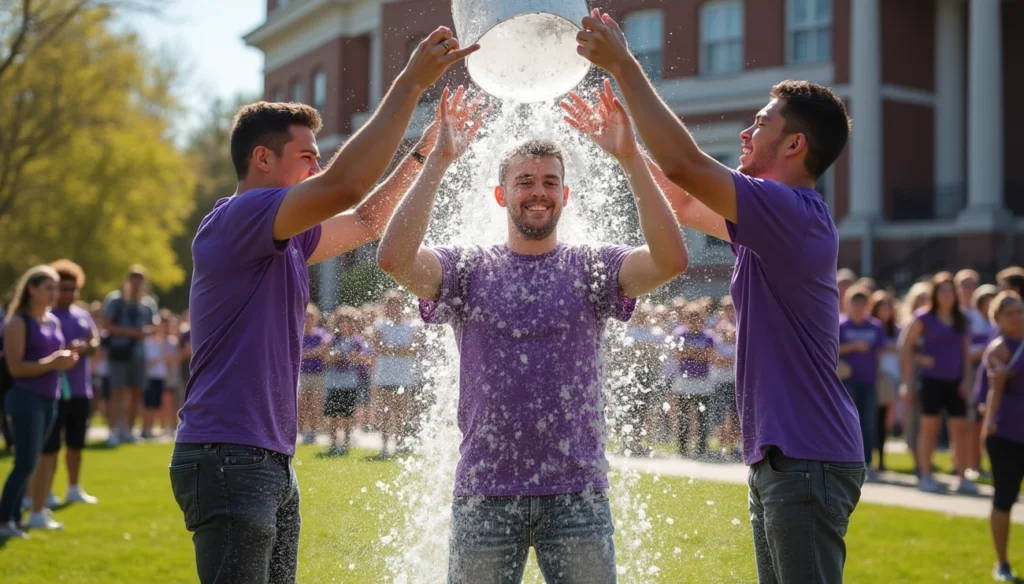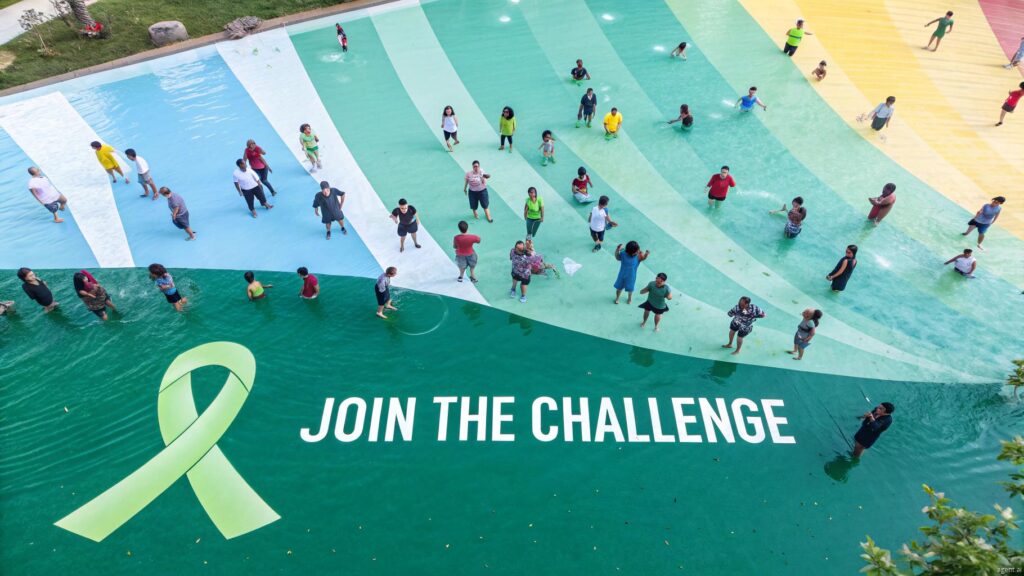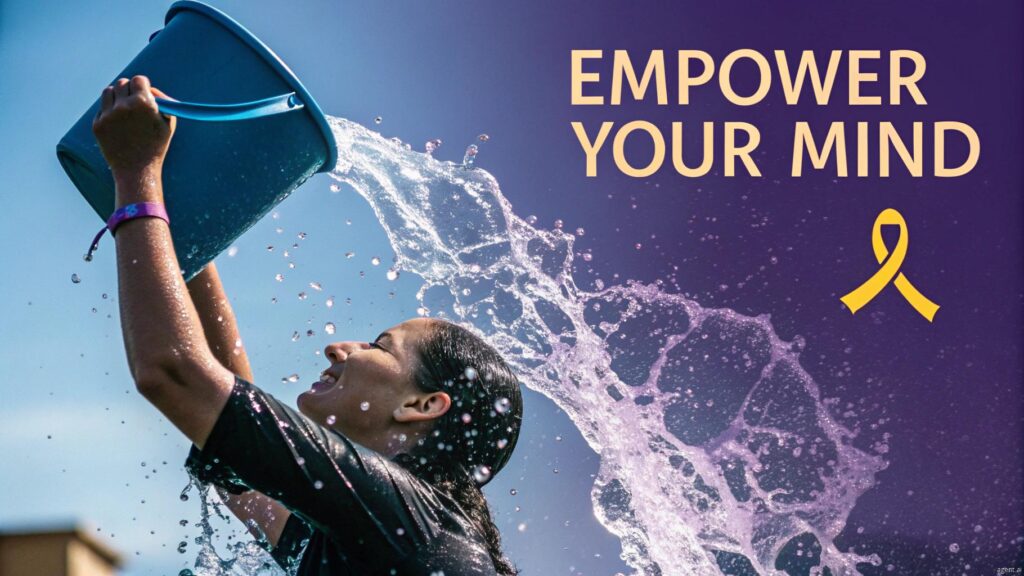The mental health ice bucket challenge has revitalized a viral phenomenon, bringing back the spirit of collective action with a focus on an equally crucial cause. Within days, this powerful movement has garnered hundreds of thousands of views, inspiring over 2,300 donations and raising more than $40,000 to support mental health resources for youth and young adults. Even more impressively, the campaign surpassed $100,000 in donations by Friday.
Ten years after the original Ice Bucket Challenge captured global attention for ALS awareness, this new iteration maintains the same engaging format while shifting focus to mental health support. At the center of this movement is the USC ice bucket challenge, spearheaded by Wade Jefferson, a junior who founded the MIND club after losing two friends to suicide. His mission is clear – to normalize conversations around mental health and make them more accessible.
For years, fundraising professionals and nonprofits have wondered, “What’s going to be our ice bucket challenge?”. Now, we have our answer. This campaign embodies everything mental health advocacy should be – bold, mission-driven, and youth-led. Just as the original challenge did for ALS, this version is turning awareness into action, proving that when young people rally together with passion and purpose, they don’t just raise awareness – they create meaningful change.
The return of the Ice Bucket Challenge
After a decade-long hiatus, the iconic Ice Bucket Challenge has made a splash comeback in 2025. However, this time around, the buckets of frigid water serve a different purpose – raising awareness for mental health rather than ALS (Amyotrophic Lateral Sclerosis).
Why 2025 is different from 2014
The 2025 revival isn’t merely a nostalgic replay of the 2014 phenomenon. Instead, it represents a strategic reimagining for a new generation facing different challenges. The original challenge was extraordinary in its impact, raising $115 million for the ALS Association, which subsequently led to another $1 billion in follow-on funding for ALS research. This influx of resources helped discover new ALS genes, launched global research collaborations, and expanded care for people living with the disease.
What makes 2025 different is not just the cause but also the cultural context. According to Brett Curtis, director of community fundraising with Active Minds, “The majority of mental health conditions are diagnosed, are happening to young people. It’s students in college and high school”. Furthermore, this generation is more open about mental health struggles, with the revival driven specifically by college students rather than celebrities.
The fundraising progress has been remarkable, with the campaign initially raising $40,000, then quickly surpassing $100,000, and according to recent reports, reaching between $242,000 and $295,000 – demonstrating the power of youth-led social movements.
From ALS to mental health: a shift in focus
The transition from ALS to mental health awareness reflects evolving public health priorities. Active Minds reports that 70% of youth and adults don’t know how to speak with a friend about mental health, despite the fact that 50% of all Americans will face a mental health condition in their lifetime.
Notably, the ALS Association has embraced this evolution rather than resisting it. “We’re thrilled to see the spirit of the ALS Ice Bucket Challenge live on in new forms of activism,” the ALS Association stated. Additionally, both organizations are collaborating throughout May 2025, which is both ALS and Mental Health Awareness Month.
As Wade Jefferson, founder of the MIND club, explained, “It started as a random idea, inspired by the original ALS Ice Bucket Challenge and how powerful that movement was. We wanted to bring that same energy to mental health”. This shift in focus maintains the symbolic act of ice water but reframes its meaning to highlight the importance of breaking the stigma surrounding mental health discussions.
How the USC Ice Bucket Challenge started

At the heart of the viral mental health movement lies a small student club at the University of South Carolina with an ambitious mission. The challenge officially began in late March 2025, when USC’s Mental Illness Needs Discussion (MIND) club posted their first video featuring students participating in what they called the #SpeakYourMIND Ice Bucket Challenge.
The role of the MIND club
The MIND club at USC isn’t just another campus organization. The name itself—an acronym for Mental Illness Needs Discussion—reflects its core purpose: making conversations about mental health as common and comfortable as those about physical health. Founded in February 2024, the club operates with three primary objectives: breaking the stigma surrounding mental health, advocating for suicide prevention on campus, and promoting daily mindfulness. Through their Instagram account, the group launched the campaign that would soon captivate millions across the country and beyond.
Wade Jefferson’s personal motivation
Behind every movement stands someone with a powerful story. For 21-year-old Wade Jefferson, founding the MIND club emerged from profound personal loss. After losing two close friends to suicide, the USC junior felt compelled to take action. “I wanted to do something about it, never wanted anyone to feel that way again,” Jefferson explained. His club’s name referenced a similar organization at his high school, showing how his commitment to mental health advocacy had deep roots. Jefferson’s personal experience fueled his determination to create a space where people wouldn’t feel alone in their struggles.
Initial goals and expectations
Surprisingly, the campaign’s creators had modest ambitions at first. Jefferson and his team set an initial fundraising goal of just $500 for Active Minds, a nonprofit focusing on youth mental health. They expected the challenge to remain confined to USC’s campus. Yet almost immediately, they witnessed something extraordinary—the campaign didn’t just meet their goal but shattered it. As donations poured in, surpassing $100,000 within weeks, Jefferson admitted being completely shocked by the widespread traction gained on social media. The student-led initiative had accidentally sparked a national movement that would soon attract celebrity participants and international attention.
What makes this challenge go viral

Within weeks of its launch, the mental health ice bucket challenge exploded across social media platforms, becoming the fifth-most popular hashtag on TikTok in the United States. What started as a modest campus initiative has transformed into a global phenomenon, attracting millions of participants and raising substantial funds for mental health initiatives.
The power of social media and video
TikTok has emerged as the primary catalyst for the challenge’s virality in 2025. More than 21,000 posts using the tag #icebucketchallenge appeared on the platform within just weeks of the challenge’s launch. Remarkably, the campaign has generated over 160,000 posts across social media platforms, surpassing even the creators’ wildest expectations.
Unlike the 2014 version that dominated Facebook and Twitter, this iteration found its perfect home on TikTok, where the platform’s highly responsive algorithm amplified its reach. As one marketing expert noted, “TikTok’s duets and remixes let people build on each other’s videos, making it viral by design”.
Celebrity involvement and endorsements
High-profile participants have played a crucial role in propelling the challenge to mainstream attention. Former NFL quarterback Peyton Manning participated and subsequently challenged his brother Eli Manning and former NFL player Emmanuel Sanders. Meanwhile, beauty influencer James Charles introduced the challenge to his 41 million followers, declaring, “I cannot believe we are back in 2014,” before highlighting the USC MIND group’s mission.
Other notable participants include TODAY show host Jenna Bush Hager (who dumped ice on co-hosts Carson Daly and Savannah Guthrie on live TV), model Haley Baylee (with 13 million TikTok followers), and several other influencers.
Simple rules, big impact
The genius of the challenge lies in its straightforward format that anyone can follow:
- Record yourself completing the challenge
- Tag and nominate others to participate within 24 hours
- Make a donation to Active Minds
- Share your video using #SpeakYourMIND and tag @uscmind
- Visit Active Minds website for mental health resources
This nomination-based structure creates a multiplier effect as each participant invites several others, exponentially growing the movement. The results speak for themselves – what began with a $500 fundraising goal has generated over $325,000 for Active Minds as of April 24, with donations continuing to pour in.
Moreover, Active Minds reports a staggering 922% increase in website traffic since the campaign’s launch, demonstrating how effectively the challenge has directed attention to mental health resources.
Why this matters for mental health awareness

“This campaign is everything Active Minds stands for—bold, mission-driven, and youth-led.” — Alison Malmon, Founder & Executive Director, Active Minds
The staggering statistics alone justify the need for mental health awareness campaigns. **[One in five adults](https://www.brylin.com/brylin-mental-health-awareness-ice-bucket-challenge/)** in the U.S. experiences mental illness each year, yet less than half reach out for help and treatment. Consequently, suicide has become the second leading cause of death among young people ages 10 to 34.
Breaking the stigma through visibility
The #SpeakYourMIND challenge tackles this crisis head-on by making mental health conversations visible and normalized. “Conversations about mental health should be just as common and just as comfortable as conversations about physical health,” explains Wade Jefferson. In fact, this campaign is more than just a trend—it’s a powerful demonstration of collective action against stigma.
Active Minds reports that its website has experienced a remarkable 922% increase in traffic since the launch of the campaign, proving that visibility creates opportunity for education and support.
Youth-led movements and their influence
Young people are at the forefront of mental health advocacy, precisely because they’re disproportionately affected by these issues. “The majority of mental health conditions are diagnosed in college and high school students,” notes Brett Curtis from Active Minds.
Given these points, it’s no surprise that youth-led initiatives are changing the landscape. According to Mental Health America, their youth leadership programs have empowered over 100 graduates with more than 2,000 applicants since launching. Important to realize, however, is that only 1 in 4 young people believe they can make a change in mental health in their communities.
Support from organizations like Active Minds
The challenge directly benefits Active Minds, founded by Alison Malmon after losing her brother Brian to suicide in 2000. “After my brother’s death, and knowing how preventable it was, I resolved—no matter what—to do something to change the way we approach mental health in this country,” Malmon explains.
Coupled with global realities—just 2% of government health budgets are allocated to mental health spending—these organizations fill critical gaps in support and advocacy.
Turning awareness into action
Beyond awareness, the campaign provides tangible resources. Participants are encouraged to share educational materials including self-care tools, ways to offer help, and information to access crisis support.
The campaign has already raised more than USD 400,000 to support Active Minds’ work mobilizing youth and young adults. First thing to remember is that this isn’t just fundraising—it’s creating a movement where young people rally together to transform mental health norms across society.
As Alison Malmon puts it: “Together, we’re not just starting a challenge—we’re creating a new era of mental health”.
Conclusion
The Mental Health Ice Bucket Challenge stands as a powerful testament to the impact of youth-led social movements in 2025. What began as a modest $500 fundraising goal has therefore transformed into a nationwide phenomenon, generating over $400,000 for Active Minds and creating unprecedented visibility for mental health resources. Subsequently, this viral sensation has accomplished what many thought impossible – bringing mental health conversations into everyday discourse across America.
Throughout this revival, we’ve witnessed how a simple act – pouring ice water over one’s head – can catalyze profound social change. Although the original 2014 challenge revolutionized ALS funding and research, this reimagined version addresses an equally urgent crisis affecting millions of young Americans. Undoubtedly, Wade Jefferson’s personal tragedy has evolved into a movement that offers hope and connection to countless individuals struggling silently with mental health challenges.
TikTok videos, celebrity endorsements, and campus activities have certainly amplified the message, but the true power lies in everyday participants who choose to speak openly about mental health. Likewise, the nomination structure ensures continuous growth, with each new participant extending the conversation further into communities previously resistant to such discussions.
Most significantly, this challenge reminds us that effective advocacy doesn’t require complex solutions – sometimes, it begins with something as simple as a bucket of ice water and the courage to speak out. The rapid growth from campus initiative to national movement proves that young people wield tremendous influence when passion meets purpose.
Ten years after the original Ice Bucket Challenge made history, its mental health counterpart carries forward that legacy while addressing the unique challenges facing today’s youth. Above all, it demonstrates that when we break the silence surrounding mental health, we create space for healing, connection, and lasting change.
FAQs
Q1. What is the purpose of the 2025 Mental Health Ice Bucket Challenge?
The 2025 Mental Health Ice Bucket Challenge aims to raise awareness and funds for youth mental health. It encourages open conversations about mental well-being and supports organizations like Active Minds in their mission to empower young people and change the stigma surrounding mental health.
Q2. How did the Mental Health Ice Bucket Challenge start?
The challenge was initiated by Wade Jefferson, a junior at the University of South Carolina, who founded the MIND (Mental Illness Needs Discussion) club after losing two friends to suicide. It began as a campus initiative that quickly gained traction on social media platforms, particularly TikTok.
Q3. How does the Mental Health Ice Bucket Challenge work?
Participants record themselves pouring ice water over their heads, nominate others to do the same within 24 hours, make a donation to Active Minds, and share their video using #SpeakYourMIND. This simple format has helped the challenge go viral and spread awareness rapidly.
Q4. What impact has the Mental Health Ice Bucket Challenge had so far?
The challenge has raised over $400,000 for Active Minds, generated more than 160,000 social media posts, and led to a 922% increase in traffic to mental health resource websites. It has also attracted celebrity participants and sparked conversations about mental health across the country.
Q5. How does this challenge differ from the 2014 ALS Ice Bucket Challenge?
While the 2025 challenge maintains the same engaging format of dumping ice water, it focuses on mental health awareness rather than ALS. It’s primarily driven by youth and college students, leveraging platforms like TikTok for virality, and aims to normalize conversations around mental health among younger generations.


